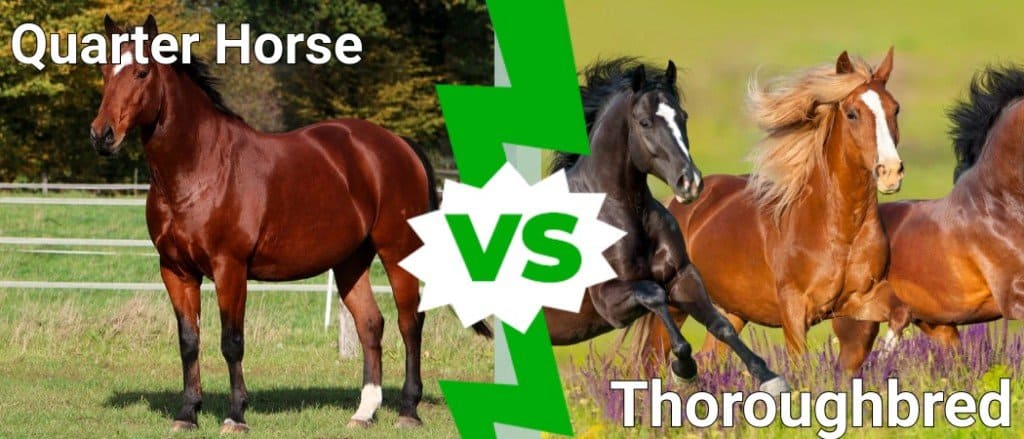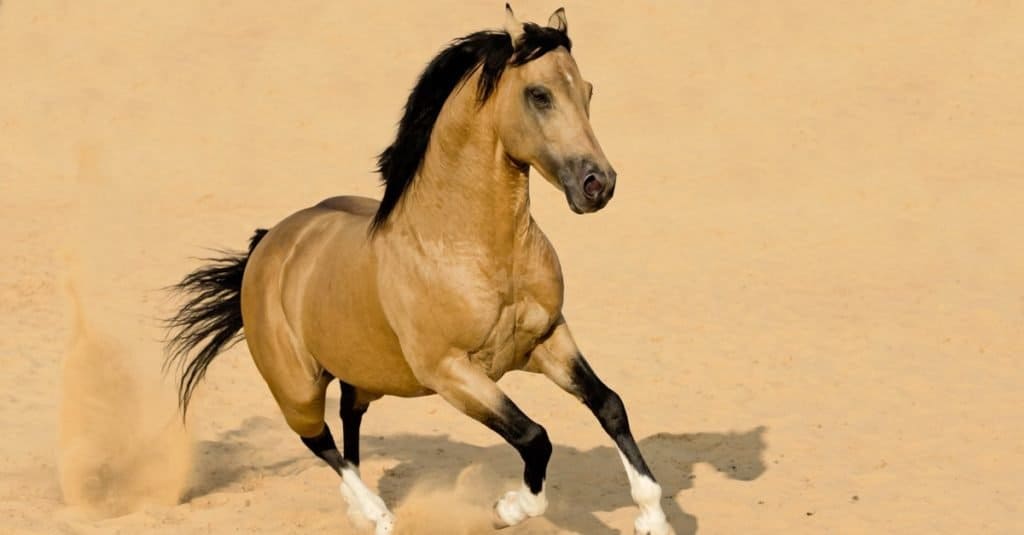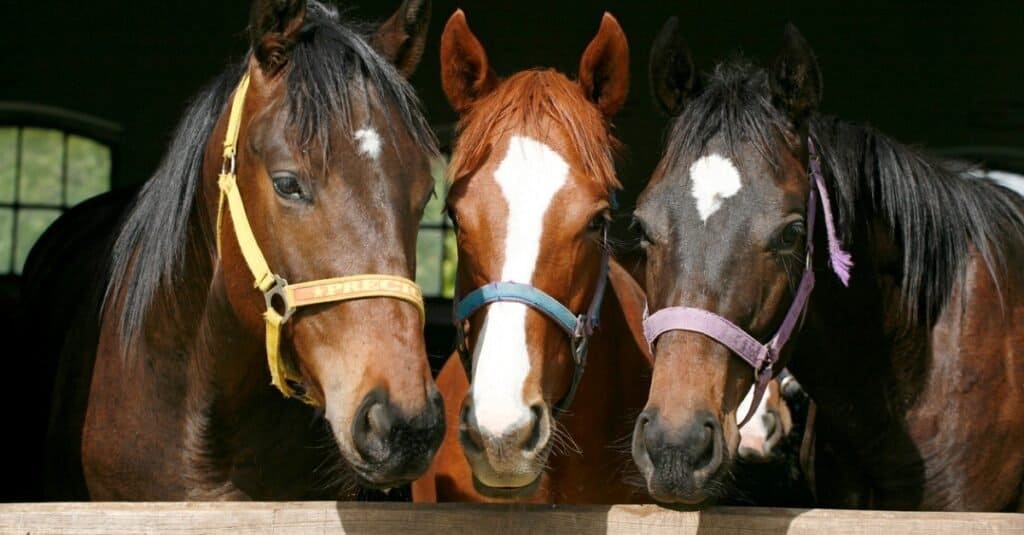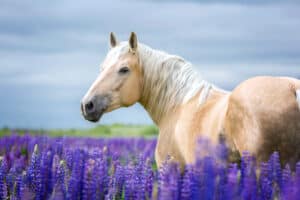Quarter Horses and Thoroughbreds are two horse breeds that are known for their racing prowess as well as the confusion surrounding their names. So, what are the differences between a Quarter Horse vs Thoroughbred? We’re going to show you several ways that these animals are unique from one another.
First, we need to clear up the confusion around their names. Quarter Horses are not named for their size; they’re not small animals at all. They’re named because they were purposely bred to run races that are a quarter mile or shorter in length.
Thoroughbreds are actually a distinct breed of horse, but pure-bred horses are sometimes referred to as thoroughbreds. We’re exploring the Thoroughbred breed in this article.
Now that we know the origins of these breeds’ names and cleared the air of some confusion surrounding them, we can delve into the things that separate these horse breeds.
Comparing a Quarter Horse and a Thoroughbred

| Quarter Horse | Thoroughbred | |
| Size | Weight: 1,000lbs to 1,200lbs Height: 56 to 64 inches | Weight: 800lbs to 1,200lbs Height: 62 inches to 68 inches |
| Speed | 55 mph top speed; it’s the fastest horse | 45 mph top speed, but it can maintain a high speed for longer |
| Lifespan | 25-35 years | 25-30 years |
| Body Type | Muscular and stocky | Lean and athletic |
| Personality | Calm, intelligent, relatively easy to train | Intelligent, stubborn |
| Breed Origins | Thoroughbred horses and Spanish horses in the U.S. | English Mares and Arabian, Barb, and Turkoman breeds imported to England |
The 6 Key Differences Between Quarter Horse vs Thoroughbred

Quarter Horses are stockier but faster than a Thoroughbred
©Bianca Grueneberg/Shutterstock.com
The greatest differences between a Quarter Horse and a Thoroughbred horse are size, speed, and body type. The Quarter Horse is shorter than the Thoroughbred, but it weighs more on average. Thus, the body type of the Quarter Horses tends to be more muscular and stockier compared with the taller, leaner-looking Thoroughbred horse.
The speed of these two animals is comparable since they share a lineage. However, the American Quarter Horse is faster than the Thoroughbred at top speeds. The Thoroughbred horse is more capable of running at higher speeds over long distances, though.
These are just three of the most important differences between the two horse breeds. We’re going to explore other distinctions between these animals that will help you better conceptualize their variances.
Quarter Horse vs Thoroughbred: Size

Thoroughbreds are taller than Quarter Horses but not as well-muscled.
©Kwadrat/Shutterstock.com
The Quarter Horse is shorter than the Thoroughbred breed, but it averages a higher weight. Also, the Quarter Horse weighs between 1,000lbs and 1,200lbs, but the Thoroughbred weighs between 800lbs and 1,200lbs.
The Quarter Horse stands between 56 inches and 64 inches tall, and the Thoroughbred horse stands between 62 inches and 68 inches tall. Thus, the Thoroughbred is a taller animal that has a lower average weight than the Quarter Horse.
Although the Thoroughbred is a large animal and can be much taller than a Quarter Horse, neither of them are among the biggest horses in the world. Still, these differences in size affect other aspects of the horses’ bodies and the outcomes they produce.
Quarter Horse vs Thoroughbred: Speed

The fastest Quarter Horse reached 55 mph!
©jacotakepics/Shutterstock.com
The Quarter Horse is faster than the Thoroughbred in terms of sheer speed, but the Thoroughbred can endure higher speeds for a longer amount of time.
The Quarter Horse was specifically bred to achieve high speeds over short distances, and this breed excels at just that. Their stocky, muscular bodies allow them to reach optimal speeds, but they lack the stride length and endurance to keep this speed for the duration of a race. The maximum speed achieved by this breed was 55mph over a short distance.
However, a Thoroughbred holds the record for the fastest speed on a quarter-mile track. These horses can run as fast as 45 mph, and they can sustain that speed for a longer time. Moreover, Thoroughbreds have been bred and trained to reach high speeds for centuries, so they are by no means slow. They would probably lose a very short race to a Quarter Horse, though.
Quarter Horse vs Thoroughbred: Lifespan
The lifespan of a Quarter Horse ranges between 25 and 35 years, and a Thoroughbred horse can live between 25 and 30 years. These horses exist solely in captivity, so they are properly cared for by people who understand the breeds and how to provide them with the healthiest lifestyles.
For that reason, these horses, especially the Thoroughbred, tend to be the most expensive horses on the planet. They are an immense investment, and it is important to have the animals live as long as possible to optimize the return on that investment in terms of races won, breeding, or show wins.
Quarter Horse vs Thoroughbred: Body Type
Quarter Horses are stocky and muscular animals, but the Thoroughbred is lean and athletic. The Quarter Horse is shorter but just as heavy or even heavier than the Thoroughbred. The result is a horse that exudes strength but doesn’t have the height to match the biggest horses in the world.
The Thoroughbred is taller and has a weight that is well-distributed across its body. This horse looks balanced lean, and ready to sprint.
Quarter Horse vs Thoroughbred: Personality
Quarter Horses are a calm horse breed that are somewhat easy to train as far as horses go, but Thoroughbreds are known for having a stubborn streak that can make them hard to teach.
Although it’s best to have an experienced hand guide the development of both horses, the Thoroughbred needs someone that knows how to train a horse by its side, or it will be disobedient. Less experienced trainers can still be successful at teaching a Quarter Horse in most cases.
Quarter Horse vs Thoroughbred: Breed Origins

Thoroughbreds were bred by the English to yield Quarter Horses, animals very fast over a short distance.
©iStock.com/acceptfoto
Quarter Horses are relatives of Thoroughbreds, but the Thoroughbred comes from mixtures of English mares along with Arabian horses and other breeds. When the English began coming to the New World, they found that horses had been introduced to the mainland through previous excursions by the Spanish.
The Thoroughbreds that made the journey were bred with these “native” horses and produced the first Quarter Horses. The Quarter Horse and the Thoroughbred have many differences between them, but they do share common ancestry.
Despite their confusing names, both the Quarter Horse and the Thoroughbred are large, fast, and beautiful creatures. They have excelled in short horse races throughout the world and will continue to dominate the sport. Both breeds are continually changing as some Thoroughbreds are being bred as distance runners rather than sprinters and Quarter Horses are being exported around the world.
What Are the Differences between Thoroughbred and Quarter Horse Racing?
Thoroughbreds and Quarter Horses run in different racing circuits because of the differences in speed and distance. Interestingly, the first Quarter Horse races were held in Virginia in 1674, but the first organized Thoroughbred race didn’t occur until 1745 in Maryland. Here are the key points about their different styles of racing:
- As previously mentioned, Quarter Horses are sprinters who run only a quarter of a mile, which at 55 mph on average means a race lasts just 20-45 seconds.
- Thoroughbreds run a half mile to 1.5 miles, which takes 1-2 minutes at their average speed of a little more than 40 mph.
- Another difference is in the way the race is conducted: in Quarter Horse racing, the clock starts when the gate opens; in Thoroughbred racing, there is a “run-up” distance, and the clock doesn’t start until the first horse pass a sensor at the selected point.
The photo featured at the top of this post is © Anaite/Shutterstock.com
Thank you for reading! Have some feedback for us? Contact the AZ Animals editorial team.






